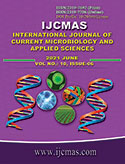


 National Academy of Agricultural Sciences (NAAS)
National Academy of Agricultural Sciences (NAAS)

|
PRINT ISSN : 2319-7692
Online ISSN : 2319-7706 Issues : 12 per year Publisher : Excellent Publishers Email : editorijcmas@gmail.com / submit@ijcmas.com Editor-in-chief: Dr.M.Prakash Index Copernicus ICV 2018: 95.39 NAAS RATING 2020: 5.38 |
Bio efficacy of six newer and selective miticides / insecticides, dicofol (standard check), abamectin (treated check) along with botanicals and biopesticides viz., azadirachtin and lecanicilium lecani were studied against Tetranichus cinnabarinus on okra crop during summer, 2015. Two rounds of subsequent foliar applications were given at an interval of two weeks. Observations on Red spider mite were recorded at 3, 5, 7 and 14 DAT. Mean pre-treatment count of 30.96 to 31.93 mites / leaf/ sq.cm. The plots treated with abamectin 1.9 EC at 0.00076% showed the lowest of 1.06 mites per leaf per sq. cm. and was proved to be the most promising treatment and it was at par with chlorfenapyr 10 SC at 0.01% (1.31 mites), fenazaquin 10 EC at 0.037% (1.45 mites) and bifenazate 50 WP at 0.037% (1.67 mites). The mite population in Lecanicillium lecanii at 1.15% was recorded 10.02 mites and it was at par with azadirachtin at 300 ppm @ 5ml/lit. (11.18 mites) and both the treatments were superior over untreated control. However, Lecanicilium lecanii and azadirachtin were not superior over chemical treatment. Whereas, they were superior over untreated check in reducing the number of mites per leaf per sq. cm.
 |
 |
 |
 |
 |